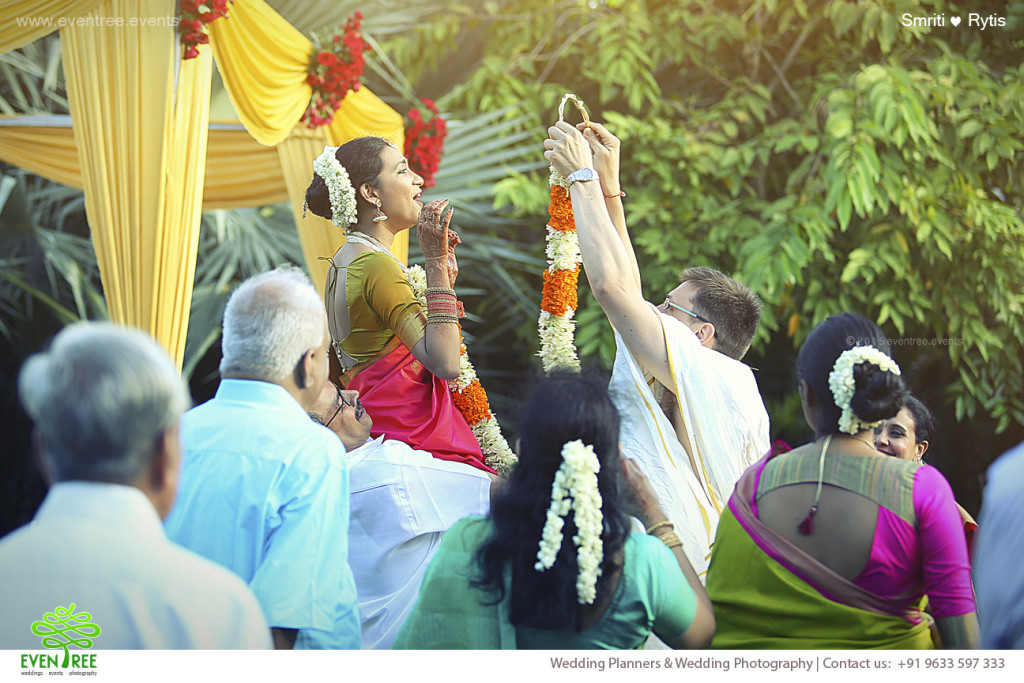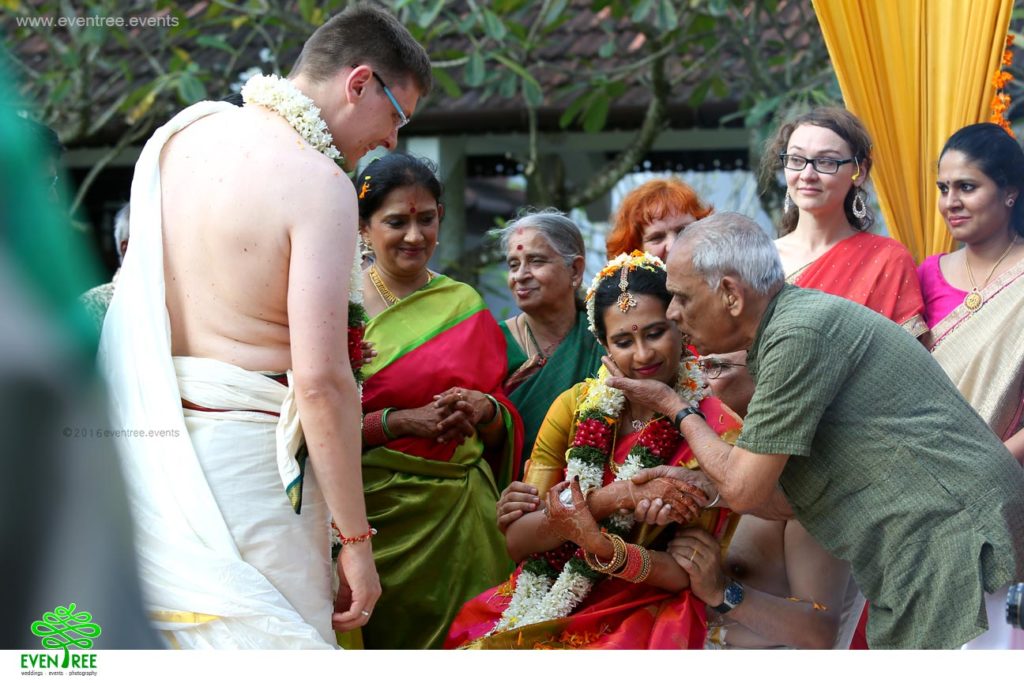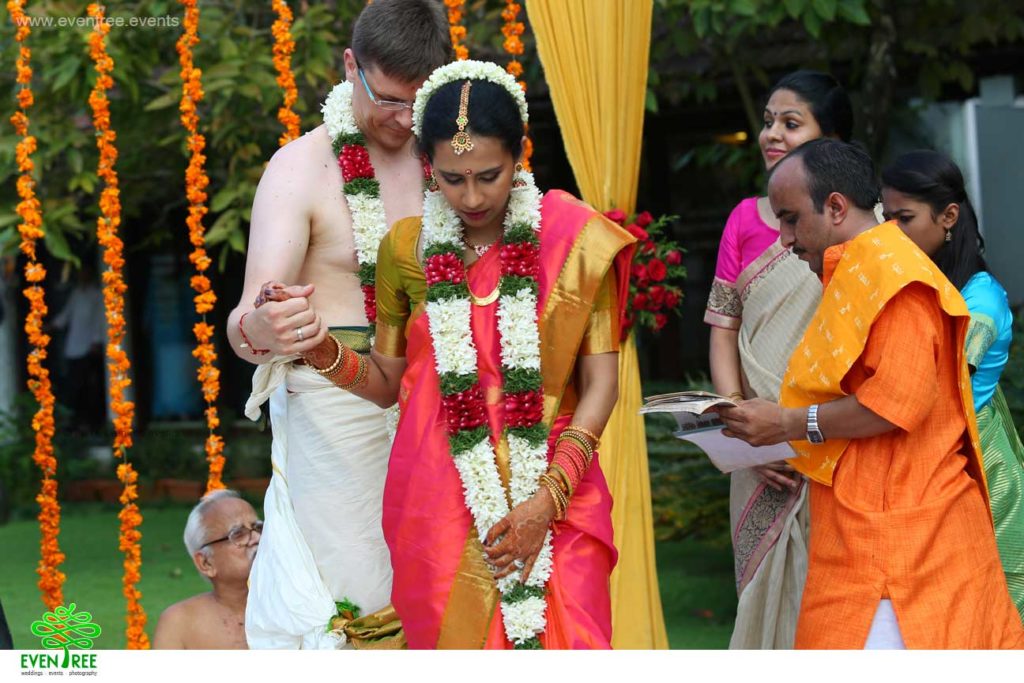Wedding celebrations across India are well-known for its vibrancy and flamboyancy. In the Southern Region of India, the Tamil Iyer caste celebrate their marriage ceremony typically over 2-3 days with a diversity of rituals. The Indian wedding attire is also renowned for its vivid colours, and it’s the same at Tamil Iyer weddings – with the male usually bare-chested and a dhoti, and the females adorned with gorgeous colourful sarees. We at Eventree have conducted destination weddings to celebrate this culture of marriage, and have learnt a thing or two (and more!) about the rites that are conducted for a typical Tamil Iyer Wedding, further described to you below. 🙂
Vrutham – The rituals commence first on the wedding day. In the early morning hours before the function, prayers are provided to the ancestors and the family seeks God’s blessings for this auspicious day. A holy thread is tied on the couple’s wrists, usually its Yellow in Colour, and they have nine assortments of grains showered on them for good fortune.
Janavasam/”Maapillai Azhaippu” – The marriage function is incomplete without the bride or groom, and this custom is the entrance of the groom! – who makes his appearance in an embellished carriage with delightful singing and dancing accompanied by the family. Nowadays, it’s common to see the bride also join this parade halfway through, and then follow on to go to the temple where the groom is provided with his attire – a dhoti and shirt – for the following ceremonial rite.
Nichayathartham (Engagement Ceremony) – The bride’s family welcomes the groom into their family, with turmeric, betel leaves, nuts and clothes – to further note the bride’s brother places a floral garland around the groom’s neck. Accompanied by this an “Aarthi’– a performance using lit lamps presented to one of the divinities – and a coconut is broken; a ritual considered to prevent them from the evil eye.
Both families are seated opposite each other on an elevated stage, where a marriage document is composed, read out and signed by the two families’. Finally, to end the ceremony gifts are given alongside silver plates filled with a mixture of delicacies of nuts and dry fruits, turmeric and ‘kumkum’.
Kashi Yatra – This custom involves the groom being dressed in the traditional dhoti, and is provided with an umbrella, a walking stick, a fan, and a piece of cloth comprising of rice and daal is tied to his shoulder. In a mock procession, he steps out of the main wedding hall to seek out other trainings, wherein the bride’s father interferes and reprimands him of the importance of married life. He also further states that the bride will be given away as a strong companion to face the troublesome tests of life – a true enough fact! 🙂
Maalai Maatral – A common enough ritual that’s seen across Iyer families, this is where as the groom agrees to his marriage the bride and groom trade their floral garlands. The couple is lifted on the families’ shoulders, and during this is when the bride and groom have to accomplish the interchange of the floral garlands.
Oonjal – As described in Smriti’s and Rytis’ wedding, the direct translation of this is a wide swing. The couple are asked to be seated on this, and the rocking oscillations of the swing act as a reminder to the soon-to-be wedded couple that no matter that troubles may arise, the respected partner will be their backbone to help surpass any problems.
Palligai Seeds Sowing – The day prior to the wedding, clay pots are used and lain inside are nine assorted pre-soaked seeds. This ritual is completed to provide blessings for the couple in their children and to have a nourishing life, and after the marriage these seeds are strewn in rivers to bring in these blessings.
Kannika/Kanya Dhanam – The bride sits on her Father’s lap for this ceremonial rite, and her hands are lifted to the groom, filled with auspicious nuts and leaves. The family then places a ring-like collar above the bride’s head, where the gold ‘Mangal Sutra’ or necklace is placed and water is poured through a small opening of the collar. In the olden days, bulls were used as the main mode of transportation with a yoke above their heads, and there were two bulls for every cart – hence since then it’s been a tradition that alludes to the idea that the marriage needs both the husband and wife to face the journey of married life together.
In this a new sari is also given to the bride, known as a ‘koorai’, usually in hues of red, and is dressed around the bride by the sister of the groom, to welcome her to the family. And finally to end this rite, the groom provides three reassurances to the bride’s father stating that for this life and the one after, he will forever continue to exist as the bride’s soulmate in happiness and grief. A sweet gesture indeed. 🙂
Kankana Dhaaranam – This is a piece of yarn that is tied to the wrist of the groom by the bride to bind togetherness under religious promises, and it’s only subsequently that the groom is conventionally permitted to touch the bride.
Mangalyadharanam – A commonly known ceremonial ritual, the ‘Mangal Sutra’ or the golden necklace is tied around the bride’s neck at a prior fixed auspicious time, in which three knots are tied; the first by the groom, and the latter two by the groom’s sister in welcoming once again the bride to their family.
Sapthapadi – A holy fire is placed at the centre of the main stage, and around this the bride and groom declare their love and promise, wherein the groom takes the bride’s right toe with his right hand to help her take seven steps around this fire. There are seven chants stated simultaneously, in which the groom requests from the Gods to prosper his would-be with food, resilience, devotion, affluence, comfort, good health and offspring.
Pala Dhanam – The interchange of gifts between the two families to illustrate the reciprocated agreement in this marriage.
Pradhana Homam – Considered to be an essential rite, the couple offer their tributes to the God of Fire, Agni, wherein they go around the fire once more and deliver sticks and ghee to offer their respect for Agni who acts as an eyewitness to the marriage.
Treading on the Grindstone – To signify the concrete establishment of their wedding, the groom takes the bride’s left toe and places it on a grindstone on the right side of the holy fire.
Arundhathi and Dhruva Nakshathram– After the ‘Sapthapadi’ and the bride’s left toe has been placed on the stone, the groom places beautiful silver rings known as “Mettis” on her toes, depicting that good virtue and values must be placed during their marriage.
Laaja Homam – Now it’s the bride’s turn to place her offerings to the fire, and with the support of her brother she provides grains of rice three times to this holy fire, whilst simultaneously murmuring five hymns.
Nalangu – To prevent the evil eye, the bride and groom are thus placed opposite each other and they apply turmeric on their respected spouse’s feet. Furthermore, this rite involves the bride gathering yellow rice in her hand and circling it around the groom’s head, three times, and also completed by the groom to the bride, for the same reason.
Jayadhi Homam – A final prayer is presented to the deities, and the fire from the centre is taken in a new clay pot and taken to the bride’s new home.
Pravesa Homam – The simplicity of this rite involves the new wife entering her new home with the preserved fire, and is done so with full honour and respect for her.
Sesha Homam – From the fire there will be some remaining ghee, which is sprinkled on the bride’s head to indicate strength and acts as a blessing for thriving children.
Thamboola Charvanam – This is where the bride’s brother provides the first betel leaf for the couple to eat, as it’s supposed to be eaten after marriage given its aphrodisiac properties.
Mangala Arathi – In order to further prevent the evil eye, lime and turmeric powder is mixed on a plate and encircled around the couple.
Shanthi Muhurtham – And finally the day comes to an end; fixed at an auspicious time, this is simply the wedding night for the happy couple. 🙂
Wedding Reception – a function where there is the introduction of the couple as husband and wife and allowing them to be photographed with their guests, with music and dinner to accompany.
Kattu Saatham – On the following day, the groom’s family is provided with an abundance of food and other travel needs as they make their onward journey to their home.
Hence as described above, Iyer weddings truly are filled with a glorious diversity of ceremonial customs that are completed for the prosperity of the bride and groom. The wedding day is no doubt a truly hectic day and can pass by like a blur! Perhaps you’re about to get married? Well, don’t be daunted just yet – our services at Eventree aim for one thing; to provide YOU with a delightful and stress-free day, just as you wish. Feel free to contact us to inquire about further details. 🙂








